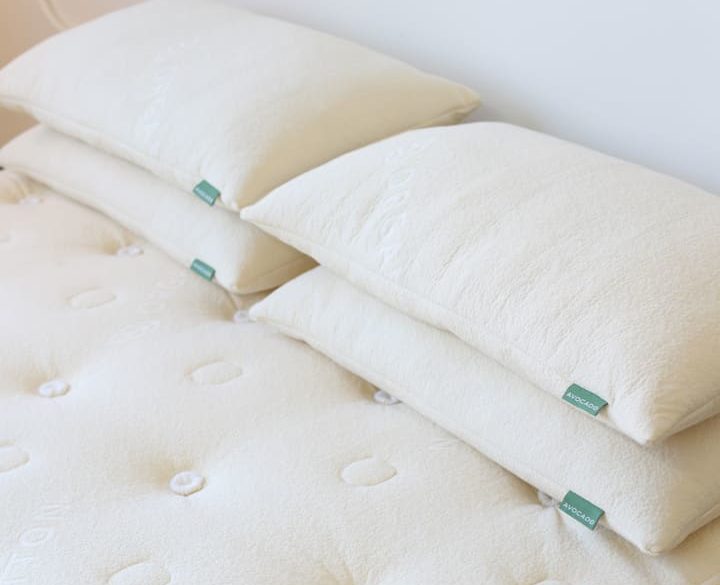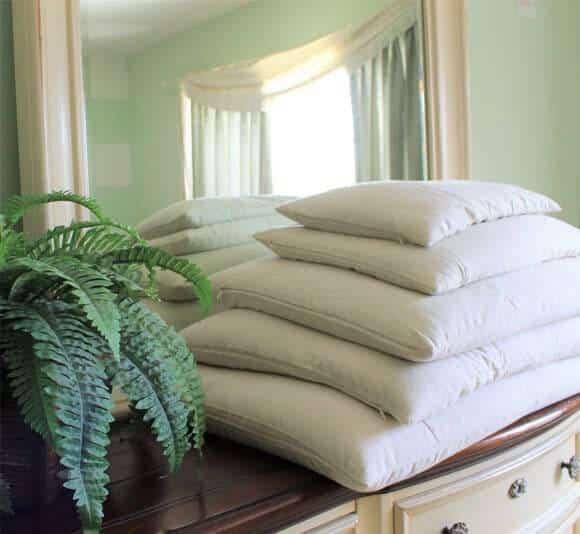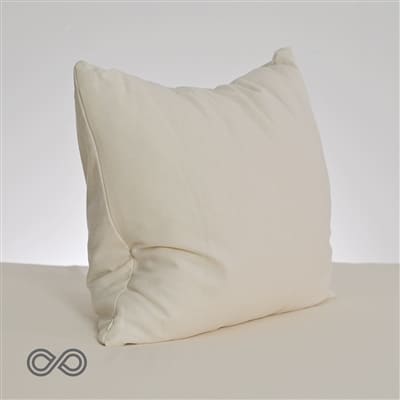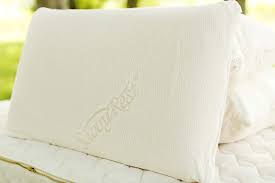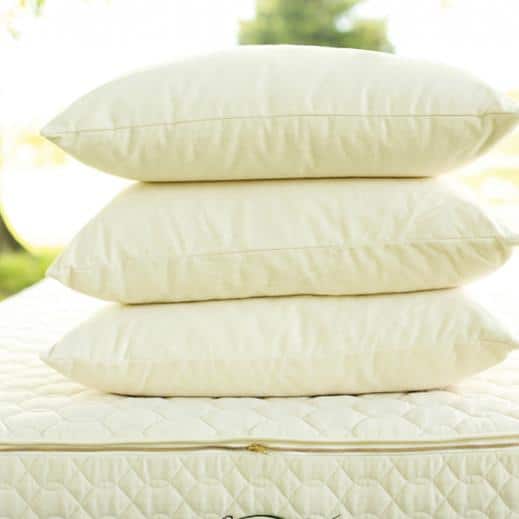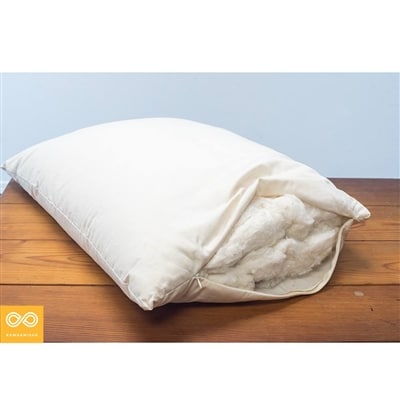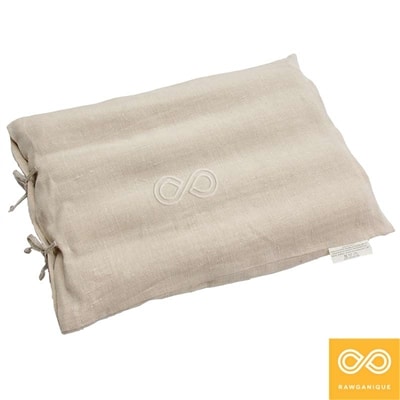A quality pillow is key to any good sleep set-up. Here, we break down the pros and cons of pillows made with kapok, buckwheat, latex, cotton, and other natural fibers and fills, plus list our top picks.
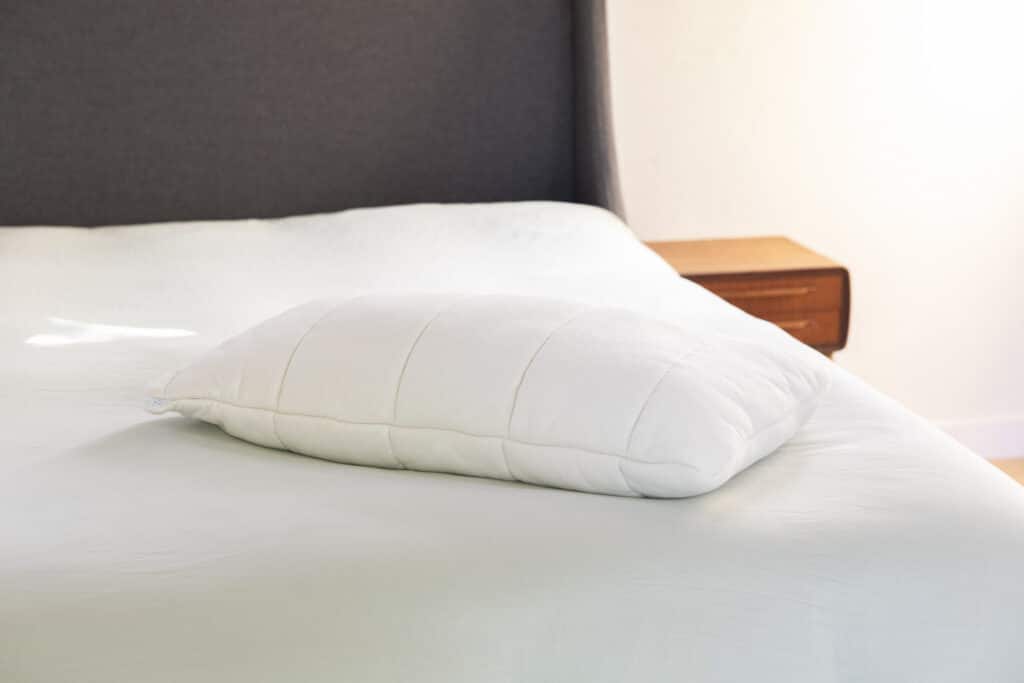
Table of Contents
Choose These Natural Materials
Most conventional pillows are made with polyester fill and a generic cotton cover. These are terrible for the environment and terrible for sleep. They also need replacing every 6-24 months!
Give yourself (and the planet) a break with a pillow made from one or more of the following:
- Kapok
- Buckwheat
- Millet
- Rubber (natural latex)
- Organic wool
- Organic cotton
- Hemp.
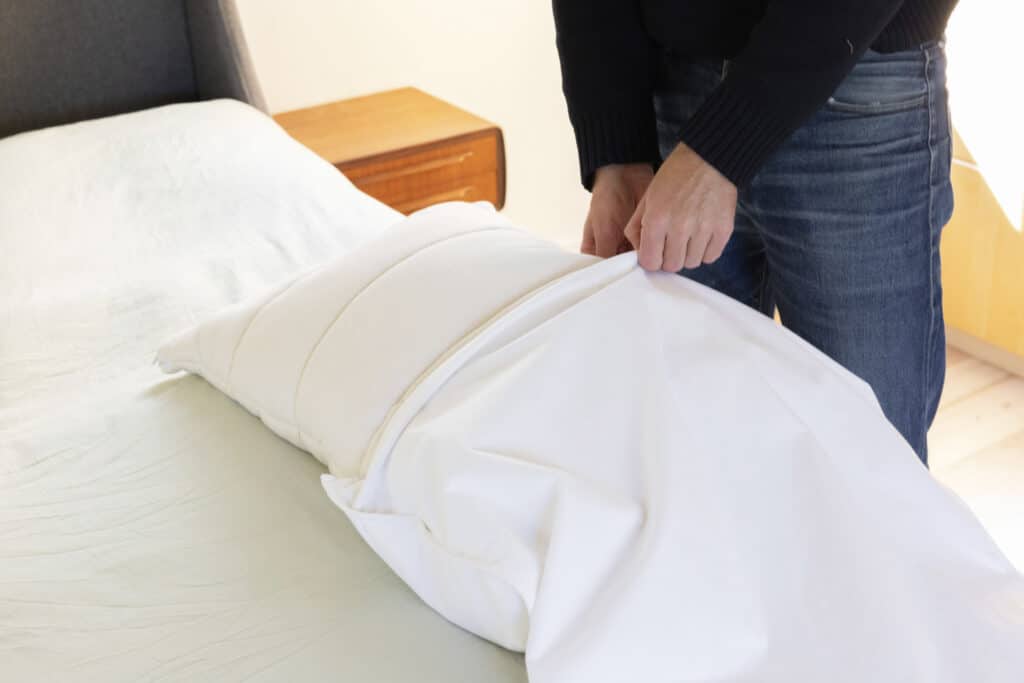
How do you know which pillow material to choose? That mostly depends on how you like to sleep, your budget, and your capacity for pillow care and maintenance (which we dig into in greater detail for every material below!
Shop LeafScore Essentials for organic bedding, including GOTS-certified organic cotton pillow protectors.
Kapok Pillows
Here’s a quick overview of the pros and cons of kapok as a natural material for pillows:
| Pros | Cons |
| Lighter than cotton | Not grown in the U.S. |
| Similar softness to down | Can cost more than other pillows |
| Hypoallergenic | Harder to find |
| Resistant to mold | Too soft for most side-sleepers |
| Fast-drying | Highly flammable |
| Machine washable | Highly oxygen-absorbent, which may make it unsuitable for anyone with respiratory difficulties and for young children |
| Durable (can last 20 years or more!) | Needs regular fluffing to restore loft |
| Sustainably grown and harvested | |
| Thermally insulating and water-repellent | |
| Bouncy and responsive |
Kapok pillows are excellent for back sleepers as they offer minimal resistance and are very soft, fluffy, and luxurious. This makes kapok a natural alternative to down. Kapok is also hypoallergenic, resistant to mold, and dries quickly.
I don’t recommend pure kapok pillows for side-sleepers as the fiber is too soft to properly support spinal alignment. Stomach-sleepers like me, however, may like how much a kapok pillow can compress but most will still prefer a pillow that’s less lofty overall.
If you do choose a kapok pillow, don’t smoke in bed and avoid using your kapok pillow near a campfire or other source of ignition.
Because kapok also absorbs oxygen very well, this can cause safety issues during kapok transportation and storage.
I’m a big fan of kapok mixed with shredded latex. This blends both the softness of kapok with the firm, buoyant support of natural latex. One of my favorite pillows, the Avocado Green Pillow is made with exactly this mix of materials and is adjustable, breathable, and super comfortable.
Buckwheat and Millet Pillows
Here’s a quick overview of the pros and cons of buckwheat and millet pillows:
| Pros | Cons |
| Conform to your head and neck for molded support | Don’t feel fluffy |
| Excellent air circulation | Can be a little noisy and crunchy |
| Helps you stay cool | Can feel too firm for stomach-sleepers |
| Easy to care for | Can be expensive |
| Easy to adjust fill (and replace fill!) | |
| Sustainable | |
| Durable | |
| Great for back- and side-sleepers | |
| naturally pesticide-free | |
| Don’t flatten | |
| Hypoallergenic and don’t hide dust mites |
Buckwheat and millet are less common pillow materials but worth exploring, especially if more conventional pillows aren’t working for you.
Buckwheat pillows are filled with buckwheat hulls and feel very different to standard pillow stuffing. They are also known as sobakawa pillows in Japan, where they are much more common than in North America.
Buckwheat hulls also adjust and conform to your neck and head, providing molded support to help with neck and back pain. Buckwheat pillows offer excellent air circulation and help your head stay cool.
Because buckwheat pillows are filled with hulls, they can also feel and sound slightly ‘crunchy’. I worried about this because I’m quite sensitive to noise, especially at night. I can definitely hear the crunch of the hulls but it’s something I got used to very quickly and barely even notice anymore. Now, my Turmerry Buckwheat Pillow is my go-to pillow that I use every night and miss sorely when I’m away from home!
Latex Pillows
Organic latex is increasingly popular as a pillow material. Latex is particularly good if you’re a warm sleeper, as it is porous and disperses heat. It is also naturally antimicrobial, resists mildew, and doesn’t harbor dust mites, so it’s good for people with asthma or non-latex allergies.
Here’s a quick overview of the pros and cons of latex pillows, for easy comparison with other natural pillow materials:
| Pros | Pros |
| Renewable, biodegradable material | Thermoregulating |
| Porous, breathable, and disperses heat well | Moisture-wicking and moisture resistant |
| Doesn’t harbor dust mites | Naturally flame-resistant |
| Resists mildew and is naturally antimicrobial | Resistant to mold, mildew, and dust mites |
| Relatively easy to care for | Antimicrobial |
| Adjustable fill (shredded latex) | Durable |
| Springy and supportive | |
| Great for back pain and neck pain! |
There are generally two types of latex pillows: molded and shredded.
I much prefer the shredded latex pillows as these are generally more versatile, especially when the pillow fill is adjustable.
In contrast, because you can’t alter the height of a molded latex pillow, you’ll need to make sure the loft works for your sleep needs. This means measuring the distance between your mattress and the side of your head when you lay down comfortably on your bed with an existing pillow.
Here are our favorite molded and shredded latex pillows.
Wool Pillows
Check out the pros and cons of wool pillows below:
| Pros | Cons |
| Thermoregulating | Too firm for some sleepers |
| Moisture-wicking and moisture resistant | Loses loft and flattens quickly |
| Naturally flame-resistant | Can be expensive, especially if well certified |
| Resistant to mold, mildew, and dust mites | Not vegan |
| Antimicrobial | May be made using toxic chemical processes |
| Durable | Heavy |
Your options for eco-friendly wool pillows are a lot more varied than for hemp or buckwheat pillows. The main issue is finding ethical wool.
Cotton Pillows
Here’s a quick overview of the pros and cons of organic cotton pillows.
| Pros | Cons |
| Soft but firm feel | Too firm and flat for most sleep styles |
| Can be less expensive than latex, buckwheat, wool, and other options | Hard to clean and dry |
| Moisture-wicking | Heavy and prone to flattening |
| Can be breathable depending on weave and fill | Hard to find |
| Grown and made in the U.S. (in some cases) | Organic cotton certification is riddled with fraud |
| Sustainable, biodegradable material |
We don’t recommend conventional cotton for pillows, but organic cotton is definitely worth considering, especially if you’re fond of a firmer style of pillow.
Organic cotton batting provides a firm sleep surface. This isn’t to everyone’s taste but can make organic cotton pillows an excellent option for stomach-sleepers looking for a flatter and thinner pillow.
Organic cotton can be very breathable, usually feels soft (but firm), and also wicks away moisture (though not as well as wool). This means a cotton pillow can help you stay cool while you sleep. I sleep on my front and sleep hot, so cotton pillows work well for me.
Organic cotton is much more sustainable than conventional cotton and should be free of:
- Pesticide residues
- Formaldehyde
- Chemical flame retardants
- Harsh chemicals such as chlorine bleach and azo dyes.
The trouble, though, is that much of the organic cotton sold worldwide could be fraudulently certified. Wherever possible, look for organic cotton grown and certified in the U.S. Avoid cotton grown in India, where organic cotton fraud is rife, unless the cotton is certified using blockchain technology that is far less vulnerable to fraud.
Hemp Pillows
Here’s a quick summary of the pros and cons of hemp pillows. For a more in-depth look at hemp pillow benefits and drawbacks, price, and sustainability, head here.
| Pros | Cons |
| Sustainable, biodegradable material | Hard to find |
| Odor-resistant | Expensive |
| Moisture-wicking | Very firm, not fluffy |
| Thermoregulating | Heavy and dense |
| Grown and made in the U.S. | Can have a natural hemp smell, especially if wet |
| Hemp farming doesn’t require pesticides, fertilizers, or much water | Harder to clean |
| Firm and supportive enough for side-sleepers |
Chances are that you’ve never slept on a hemp pillow and never will. This material is a top choice for sheets, and is also great for other home textiles, but it’s rather firm as a pillow fill.
Hemp is naturally odor-resistant, moisture-wicking, and thermoregulating. It is a fantastic material in hot and humid places and for anyone who sleeps very hot and sweaty.
While looking for hemp pillows as part of my research for this guide, I thought I’d hit the jackpot. There were thousands of results for a simple ‘hemp pillow’ search. Amazing, I thought! People have really caught onto the benefits of hemp.
Nope.
Unfortunately, most of the ads and search results were actually for pillows infused with CBD that claim (without evidence) to reduce anxiety and back pain.
These are not hemp pillows and usually comprise synthetic materials such as polyester with CBD microbeads of some kind.
FAQs
The perfect pillow for you will depend on a whole slew of factors. The softness of your mattress, how you sleep, and your budget and existing bedding can all influence your choice of pillow. I’ve done my best to anticipate common questions below.
Even if a pillow is made with natural materials that are resistant to water, bed bugs, dust mites, and other pests, it’s still a good idea to protect them with a tightly woven pillow encasement. This means you don’t have to worry about cleaning the entire pillow and can instead just wash the cover and pillowcase to reduce allergens.
Some polyfoam pillow makers boast that memory foam is less prone to dust mites than down or feathers. This isn’t true. The best way to minimize dust mite allergen exposure is to cover pillows and your mattress with allergy-proof encasements and to wash other bedding regularly (once a week). Regular vacuuming with a HEPA filter vacuum and the use of a HEPA air filter in the bedroom can also help, as can keeping household humidity levels low.
PLA is short for polylactic acid, which is a high-performance polyester made from starchy plants rather than petroleum. PLA is very versatile and is often used in fabrics and as stuffing for comforters, pillows, mattresses, and even children’s toys. You’ll also find PLA in food packaging and biomedical supplies.
PLA isn’t present in many pillows, but some companies have begun using it in place of polyester. PLA is soft and resilient, more so than conventional polyester, and resists body impressions, meaning it helps support proper spinal alignment when used in pillows.
So far, there’s no source of organic certified PLA. Instead, companies such as Naturepedic use PLA made from non-GMO sugarcane. This PLA doesn’t off-gas, the pillows are machine washable, and they’re also lighter and softer than cotton and more affordable than kapok.
Great question!
The trouble with PLA is that while its manufacture doesn’t require any toxic chemicals, the resulting bioplastic is not biodegradable or easy to recycle. In fact, PLA that enters the recycling stream can compromise recycling of other plastics because it has a lower melting point.
Researchers have found that PLA breaks down into microplastics quite quickly (faster than other plastics), especially in water, but takes a lot longer than natural fibers to actually biodegrade. This can pose significant risks to aquatic life and birds.
All in all, we don’t recommend PLA pillows. If you do get a PLA pillow, use a microplastic filter if you wash it in the machine, try to repurpose the pillow filling if the pillow no longer suits you, and take care to dispose of it carefully at end of life.
